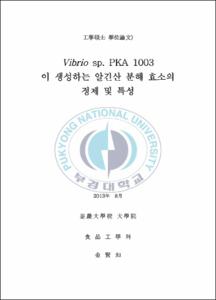Vibrio sp. PKA 1003이 생성하는 알긴산 분해 효소의 정제 및 특성
- Abstract
- Alginates are a quite abundant in nature. In brown algae, they are produced as a structural component, comprising up to 40% of dry weight. Alginate is a linear polysaccharide in which β-D-mannuronate (M) and α-L-guluronate (G) are covalently (1-4)-linked in different sequences. α-L-Guluronate is C5 epimer of β-D-mannuronate. The alginate has unique physical properties such as high viscosity and gelling property. So, alginates are widely used as stabilizer, viscosifier, and gelling agent in the food and beverage, paper and printing, biomaterials, and pharmaceutical industries. Also, alginates have various functions such as anticancer, antibacterial, anti-cholesterol and immuno stimulating activity. So, numerous studies are going on to improve its uses, and one of them is lowering molecular weight through alginate-degrading. Alginate oligosaccharides have been shown some interesting biological activities. Thus, alginate lyases have attracted much attention as biocatalysts for preparation of functional oligosaccharides. Now, alginate lyases have been found and isolated from various sources, such as marine algae, marine invertebrates, marine and some soil microorganisms, but there is still no report on high efficiancy alginate-degrading enzyme. Thus, this study was conducted to screen and isolate the high efficiancy alginate-degrading enzyme from marine microorganism. The marine bacterium producing alginate-degrading enzyme was isolated from brown seaweed (Sargassum thunbergii). The results of 16S ribosomal RNA sequence analysis was the strain the genus Vibrio and the strain was subsequently named Vibrio sp. PKA 1003. The optimum culture conditions for the growth of Vibrio sp. PKA 1003 were at pH 7, 3% NaCl, 25℃, and 6% alginic acid with 48 hour incubation time. A crude enzyme preparation from Vibrio sp. PKA 1003 showed its highest levels of alginate-degradation activity when cultured at pH 9, 30℃, and 6% alginic acid with 63 hour incubation time. Thin layer chromatography analyses confirmed that the crude enzyme released monomers or oligomers from sodium alginate, and results from trypsin treatment showed that the alginate degrading activity depends on this enzyme production by Vibrio sp. PKA 1003. To verify effects of pH, temperature, NaCl, metal ion on alginate-degrading activity, Alginate-degrading enzyme produced by Vibrio sp. PKA 1003 which was purified by ammonium sulfate with salting-out, dialysis, DEAE-sephadex, Sephadex G-100 and Sephacryl S200-HR column chromatography (Specific activity : 12.27 U/mg). The purified enzyme showed its highest levels of alginate-degradation activity when cultured at pH 7, 25℃ and 0.02 M NaCl. Ca2+, Fe3+, Co2+, Mg2+ and K+ suppressed the activity of purified alginate-degrading enzyme. Compared with the control, Hg2+ was no significantly changes on activity. The Km and Vmax values of purified alginate-degrading enzyme appeared as 1.175 mg/mL and 3.598 U/mL. These results suggest that Vibrio sp. PKA 1003 and its alginate-degrading enzyme is useful for the production of alginate oligosaccharides.
- Issued Date
- 2013
- Awarded Date
- 2013. 8
- Type
- Dissertation
- Publisher
- 부경대학교
- Affiliation
- 대학원
- Department
- 대학원 식품공학과
- Advisor
- 안동현
- Table Of Contents
- 목 차
Abstract ⅳ
서 론 1
재료 및 방법
1. 실험재료
1-1. 알긴산 분해 균주의 분리 및 동정 7
1-2. 시약 7
2. Vibrio sp. PKA 1003 생육 조건 확인
2-1. 생육활성 측정 8
2-2. pH 8
2-3. NaCl 농도 8
2-4. 온도 9
2-5. 배양 시간 9
3. 조효소의 특성
3-1. 조효소의 제조 9
3-2. 알긴산 분해능 측정 9
3-2-1. 점도 측정 9
3-2-2. 환원당 정량 10
3-3. pH 12
3-4. 온도 12
3-5. 기질 농도 12
3-6. 반응 시간 12
4. 알긴산 분해산물의 TLC 분석 13
5. 알긴산 분해 조효소액에 대한 trypsin의 영향 13
6. 효소 정제
6-1. Ammonium sulfate 염석 및 투석 14
6-2. Ion-exchange chromatography 14
6-3. Gel chromatography 16
6-4. 단백질 농도 측정 16
7. 정제 효소 특성
7-1. pH 영향 18
7-2. 온도 영향 18
7-3. NaCl 농도 영향 18
7-4. 금속 특이성 19
7-5. 알긴산 분해 양식 19
결과 및 고찰
1. 알긴산 분해균의 분리 및 동정 20
2. Vibrio sp. PKA 1003 생육 조건 확인 22
2-1. pH 22
2-2. NaCl 농도 23
2-3. 온도 24
2-4. 배양 시간 25
3. 조효소의 특성 30
3-1. pH 30
3-2. 온도 31
3-3. 기질 농도 31
3-4. 반응 시간 35
4. 알긴산 분해산물의 TLC 분석 37
5. 알긴산 분해 조효소액에 대한 trypsin의 영향 39
6. 효소 정제 41
7. 정제 효소 특성 49
7-1. pH 영향 49
7-2. 온도 영향 49
7-3. NaCl 농도 영향 53
7-4. 금속 특이성 53
7-5. 알긴산 분해 양식 53
요 약 57
참 고 문 헌 59
감 사 의 글 73
- Degree
- Master
- Files in This Item:
-
-
Download
 Vibrio sp. PKA 1003이 생성하는 알긴산 분해 효소의 정제 및 특성.pdf
기타 데이터 / 1.44 MB / Adobe PDF
Vibrio sp. PKA 1003이 생성하는 알긴산 분해 효소의 정제 및 특성.pdf
기타 데이터 / 1.44 MB / Adobe PDF
-
Items in Repository are protected by copyright, with all rights reserved, unless otherwise indicated.